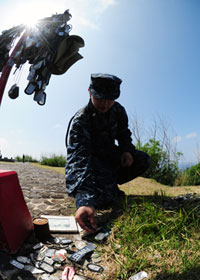U.S. Navy Dog Tag History
The purchasing of unofficial identification tags goes back to the Civil War. In the Navy, official identification tags, nicknamed "dog tags," go back to World War I. They were first prescribed by Secretary of the Navy Josephus Daniels in General Order No. 294 of 12 May 1917. These first tags were oval, of Monel metal (a patented corrosion-resistant alloy of nickel and copper, with small amounts of iron and manganese), 1.25 inches wide and 1.5 inches long. Perforated at one end, a single tag was to be worn around the neck on Monel wire "encased in cotton sleeve." One side of the tag bore an etched print of the right index finger. The other side was stamped "U.S.N." and etched with the individual's personal information. Officers' tags bore initials and surname; rank; and date of appointment, in numerals denoting month, day and year (e.g. 1.5.16). Enlisted tags bore initials and surname, with date of enlistment and date of birth, in numerals as on officers' tags.

(U.S. Navy photo by Mass Communication Specialist 2nd Class Daniel Hinton/Released)
The tags were, apparently, not used in the years after World War I. The Bureau of Naval Personnel Manual, 1942, provided that, "in time of war or other emergency, or when directed by competent authority, individual identification tags shall be prepared and worn by all persons in the naval service," suspended from the neck or from the wrist on cotton-sleeved Monel wire. Monel metal chain could be used at the individual's expense. These still appear to have been individual tags. Tags continued to be made of Monel metal, 1.25 by 1.5 inches, but perforated at each end. The face of each tag was to bear the individual's name; officer rank or enlisted service number; blood type; if vaccinated for tetanus, the letter "T" with date in numerals (e.g. 8/40); and service (USN, USMC, USNR, USMCR). A right index fingerprint was etched on the reverse.
As World War II went on, a change to the Bureau of Naval Personnel Manual prescribed the use of a second tag, individually suspended by a short length of chain so that one tag could be removed "on death or capture, leaving the other in place." Dimensions remained the same, but the tag was to be of "corrosion-resistant material" (Monel metal was no longer specified), perforated at each end, and the etched fingerprint was omitted. Markings consisted of name; officer file number, or enlisted service number; blood type; date of tetanus inoculation; service; and religion, if desired by the service member: Catholic (C), Protestant (P), or Hebrew (H). When a service member was buried, ashore or at sea, one tag was to be left with the body and the other sent to BuPers "as soon as practicable under the circumstances."
Post-World War II tags were worn on a bead chain, with attached short loop for the second tag. They bore name (surname, followed by initials); service number; service; blood type; and religion, if desired by the individual.
Sources of Information:- Braddock, Paul F. "Armed Forces Identification Tags." Military Collector & Historian 24, No. 4 (Winter 1972): 112-14
- Bureau of Naval Personnel Manual, 1942 and 1945
- Department of the Navy - Naval Historical Center, 901 M Street SE, Washington Navy Yard, Washington DC 20374-5060


